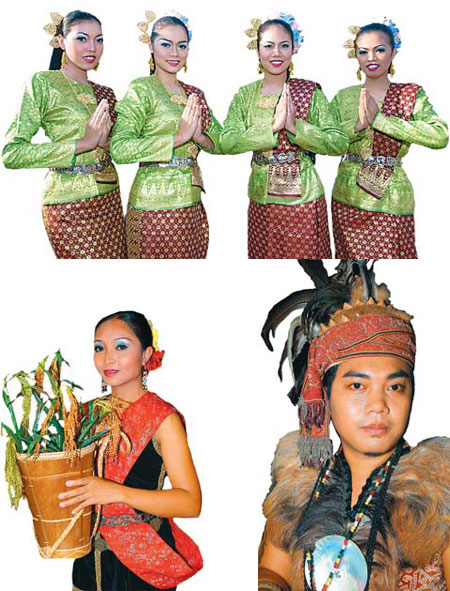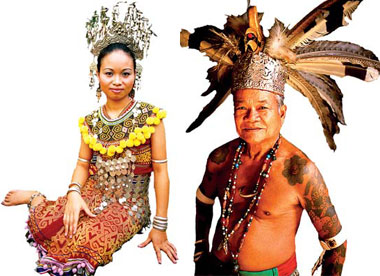Malaysia: Asia's cultural melting pot

Malaysia has been at the crossroads of cultures since the dawn of antiquity. As far back as 200 AD, the first Oriental Gold Rush lured seafarers from Rome, India and China to the tin mines of the Golden Chersonese, as the Malay Peninsula was then called by the Greek geographer, Claudius Ptolemy.
Many of the sojourners returned home, but some, mainly the Indians, remained behind in their El Dorado, where they married local women and introduced elements of their lifestyle into their adopted land.
Although the population of Malaysia mainly comprises people of Malay, Chinese, Indian, Iban, Bidayuh and Kadazan-Dusun ethnicity, actual Malaysian society is like a deftly woven fabric with threads of Portuguese, Dutch, English, Arabic and other cultural influences. As a result, diverse cultures and multi-racial communities have co-existed peacefully in unity and harmony for a long time in Malaysia.
The country's leaders' pragmatic approach to formulating socio-economic policies has enabled it to overcome problems of imbalance that usually exist in any plural society. Today, nowhere else in the world could one find a more united multi-racial society than in this cosmopolitan nation.
Baba & Nyonya
Early Chinese influence on the country can be traced back to 1459, when Princess Hang Li Poh of China (Han Libao in Chinese), along with some 500 ladies in-waiting, arrived at Bukit China in Malacca, near the southern tip of the Malaysian peninsula.
Historical records show that the marriage between the Chinese princess and Sultan Mahmud of Malacca marked the first official endorsement of inter-racial marriage and integration between the races. This led to Malacca becoming a racial and cultural melting pot, from which emerged distinct subgroups who survive to this day. Noticeable among them are the Peranakan or Straits-born-Chinese.
When the early Chinese settlers intermarried with the locals, they adopted native ways, including the Malay language, and the Peranakan culture evolved through a blending of Malay and Chinese elements. Their male descendants are known as baba, while the females are called nyonya.
The first Europeans
The Portuguese were among the first Europeans to settle in Malacca, and they remained for more than a century, creating an indelible impression on the socio-economic development of the region.
Today, their descendants residing in the Portuguese Settlement in Ujong Pasir, Malacca, are staunch Roman Catholics who still uphold the values of their forefathers. They speak cristao (cristang), which is based on Portuguese.
The Branyo, derived from Portuguese folk dance, is performed every Saturday at the Portuguese Settlement in Malacca.
Saturday nights signify fiesta time in the Portuguese Square at Ujong Pasir, as people perform Portuguese folk songs and dance the branyo. Guests are served a range of delicious, spicy Portuguese dishes like baked fish, devil's curry, karing-karing and soup.
The Portuguese, however, were not the only Europeans to arrive and settle in Malaysia. They were followed by the Dutch in 1641 and the English in 1876.
 Indigenous tribes
Indigenous tribes
The East Malaysian states of Sabah and Sarawak on the island of Borneo are home to various native races and indigenous tribes who lead a harmonious existence. In fact, most of the country's indigenous tribes live in this area. Among the largest tribal groups in Sarawak are the Iban, the Bidayuh (formerly known as the Land Dayak), the Melanau and the Orang Ulu (people of the interior).
Every year, numerous events and activities showcase the various celebrations of the indigenous communities. These efforts help keep alive their ethnic customs, traditions and festivals.
The Kadazan-Dusun tribe of Sabah is predominantly settled along the state's west coast. They are seasoned agriculturalists and renowned rice producers. Their rice harvest festival held in May is called Kaamatan.
Another Sabahan tribe, the bajau or sea gypsies, are known as the "Cowboys of The East" because of their excellent horse riding skills. Every Sunday, the bajau converge at the tamu (Sunday market) in the town of Kota Belud to sell their wares.
More foreign influences
In the 19th and 20th centuries, there was an increased influx of immigrants, especially from India, China, Java, Sulawesi and Siam (Thailand), who came to seek their fortunes in the tin mines, rubber plantations and the British administration of Malaya's civil service offices. Subsequently, there emerged sizeable foreign communities alongside the indigenous Malay population.
During early wars with the Dutch, the Malay rulers brought in Bugis, Javanese and Achinese mercenaries to fight for them, especially in Johor and Kedah. The Minangkabau from Sumatra also migrated to Malaya, with many settling in Negeri Sembilan.
Racial harmony
Today, the diversity of Malaysian customs and traditions reflect the nation's rich cultural heritage as seen in the kaleidoscope of exotic dances, handicrafts, festive pomp and pageantry, folk arts and sports.
Malaysians from all walks of life celebrate a variety of festivals throughout the year because they place a great deal of importance on their respective cultural practices.
Visitors to Malaysia are feted with the pomp, splendor and pageantry of Citrawarna Malaysia or "Colors of Malaysia" each May and June. This annual treat is a cultural extravaganza portraying the songs, dances, arts, traditions and cuisines of the country.
Religious tolerance among Malaysia's population of 25.7 million, comprising diverse races, backgrounds and beliefs, is the main factor that helps the government maintain the country's peace, racial harmony and pace of progress.
Unity in diversity
The numerous celebrations across the nation go beyond the songs and dances performed. They are rather a testament to the Malaysians' love for peace. Foreign visitors are often pleasantly surprised by the tolerance and goodwill that prevail in the country. It goes to show that a people so divided in their descent, religion and culture can achieve much through national harmony and unity.
Courtesy of the Malaysian Embassy in China
(China Daily 08/31/2007 page23)














